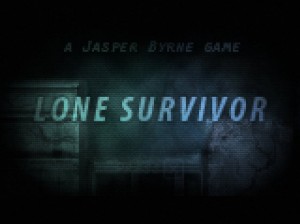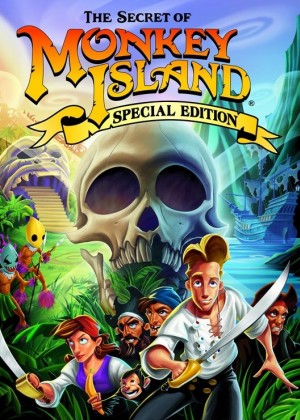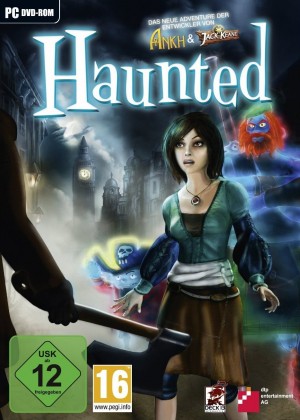Casual Invasion: Concealing Hidden Dangers
Note: This article's subtitle has been changed from "Killing a genre softy" to avoid any potential confusion. The original phrase was purely facetious, and was never meant to be taken literally. The threat is real, but any adventure fan knows the genre will never die! And certainly not if Adventure Gamers has anything to say about it.
I’m sure we’ve all heard the argument that “Doom killed the adventure genre.” And true enough, id Software’s phenomenally successful 1993 shooter literally blew the doors wide open for 3D action games. It didn’t kill adventures, though. It mercilessly shot the genre with a BFG, wrestled the mainstream gaming crown from its pacifistic head, and even kicked it a little when it was down, but Doom didn’t kill it.
You know what might? I-Spy.
Okay, I promised in my last blog that I wouldn’t speak of the death of the genre (but hey, it worked better with the Doom imagery), and Scholastic’s children’s games are barely known in wider circles, let alone a threat to topple the once-mighty adventure. But the I-Spy games were a precursor to a very real and imminent threat, and in the second of three attempts to depress the hell out of everyone (no, not really, but it may have that effect), the subject is none other than: casual games.
Casual games aren’t new, of course. They’ve been around practically forever, and come in all shapes and sizes and gameplay types. Until recently, there’s been enough separation between “us” and “them” that it hasn’t been much of an issue. But in recent years the “hidden object” games have exploded in popularity, and as evidenced by the start of our recent feature focus, they’ve now become impossible to ignore.
There are two central concerns where these seek-and-find games are concerned, and each has the potential to impact adventures significantly. The first is that adventures are becoming more and more like casual games, and the second is that the casual games market itself is quickly forming a shadow that looms over the entire genre.
Let’s begin with the issue of adventures becoming more casual. For the sake of convenience, we’ll include episodic gaming in this topic, even though there’s nothing inherently casual about shorter, episodic games. The fact that those released (most notably from Telltale so far) have trended along these lines, however, indicates a correlation if not causation. (And I promise that’s the last time I’ll sound all science-y).
Let’s face it, today’s adventures are getting easier. Not insultingly easy, but easier than the olden days of weeks-to-solve puzzles, help hotlines, and mail-order guide books. With walkthroughs at everyone’s fingertips and the pace of life getting more and more hectic, fewer and fewer people are willing to devote the same kind of time and energy to complex puzzles, and developers are accommodating us. Simpler puzzles and in-game hint systems abound, and the days of Myst are over. Some say good riddance, some lament, but few would argue the point.
But now games are going even further. By their very nature, adventures are still perhaps the most demanding, least rewarding games on the market. Who likes wandering around for half an hour not knowing what to do, or slaving over one puzzle just to run smack dab into the next obstacle? Well, we do, but only to an extent, and that “extent” has begun to slide. Seeing this trend early, adventure giant Jane Jensen was among the first to embrace it, co-founding Oberon Games and creating the Inspector Parker series and BeTrapped!. Revolution’s Steve Ince went the casual route with his first solo effort as well, albeit in the more action-oriented Mr. Smoozles Goes Nutso.
For a long time, however, the “trend” seemed stuck in neutral. But the trickle-down effect has finally begun. While not replacing their regular adventure counterparts (merely adding to them at this point), both the CSI and Nancy Drew series have now launched distinctly casual installments. And it doesn’t stop there. From the new indie series Casebook to the upcoming Three Cards to Midnight by still another genre legend (the creators of Tex Murphy), it’s clear that this is now indeed a trend, not a fluke. It’s even working the other way, as more adventure elements are being added to casual games, like in the recent Mystery Case Files: Return to Ravenhearst.
No point hiding our heads in the sand and hoping the trend passes. Trends do pass, but we’re only at the beginning of this one, and even when it finally subsides, I suspect the genre won’t ever be the same. Not dead… but not the same.
Having said that, we’d be lucky if that was the only challenge posed to the genre by casual games. The other one is even more ominous: namely, that the casual games market will severely erode the adventure game market in its own right. We’ve been lulled into a false sense of security in recent years by the genre’s increased prosperity, all the while oblivious to the ground swell of popularity of the genre’s nearest competitor.
For those who haven’t played them, hidden object games are basically “adventure lite” experiences. They’ve got a story framework, they’ve got puzzles, they’ve got pretty pictures. They rarely give you any freedom or exploration, but instead offer the one thing that adventures so desperately lack: a constant sense of challenge and fulfillment. Ten minutes of an adventure means practically nothing. Ten minutes of seek-and-find games means twenty small victories. Sure they’re largely ongoing “pixel hunts”, but it’s this continual feedback loop that makes the casual games so much more appealing than adventures for many people.
And guess what? They’re cheap. The adventure genre was basically kept afloat by DreamCatcher in the last dark period by offering adventures at “budget” prices. And budget games always do well, almost regardless of quality. Now most adventures have edged back up into regular game price ranges, and suddenly a purchase is not so automatic. The economy’s in the tank, and everyone’s looking for value, and you can’t afford to be wrong with that extra $10-20 dollars. The new “budget” value, then, is casual games. More rewarding AND cheaper begins to look better and better.
Publishers and developers love them, too. As Jensen noted in a recent interview, ”casual games have a short timeline and lite budget. So things happen very fast. You have a month to do the design, in another month you’re seeing weekly builds and in 5 months you’re shipping. A big adventure game takes a lot longer all the way around.” What does that mean for the consumer? It means the market is being flooded with them, and those that like both hidden object games and adventures now have to choose. And if there are twice as many new casual games released at half the cost of an adventure... well, you do the math.
Can the two co-exist? Yes, but not comfortably. There will always, ALWAYS be room for full-fledged adventures. Snacks are great, but people will inevitably crave full-course meals from time to time. Still, the two share the same general demographic market, and whenever competition exists, something has to give. Will already-reluctant publishers still be as willing to invest in new adventures as they become increasingly speculative?
If there are any positives stemming from the influx of casual games, it’s in their ability to popularize digital distribution and draw attention to adventure games that didn’t exist before. The existing adventure community has always been slow to embrace change, and the acceptance of downloadable games is no exception. But because casual games are typically offered only by download, they’ve helped force the issue. Whether that ever translates into more adventures routinely downloaded remains to be seen, but at the very least popular casual game portals like Big Fish Games are now offering adventures as well. It’s small consolation, but it’s a start.
Love them or hate them, then, casual games are here to stay, and the genre will need to find its way through this new reality. No, I-Spy won’t kill adventures, but in keeping with the spirit of its name, take a good long look at the gaming landscape now, because it may not look that way much longer.
Next week (or thereabouts), stay tuned for part three of this “reasons to make you investigate new hobbies” series. (Just kidding. I hope.)
This article originally appeared in Adventure Gamers' now-defunct blog.













